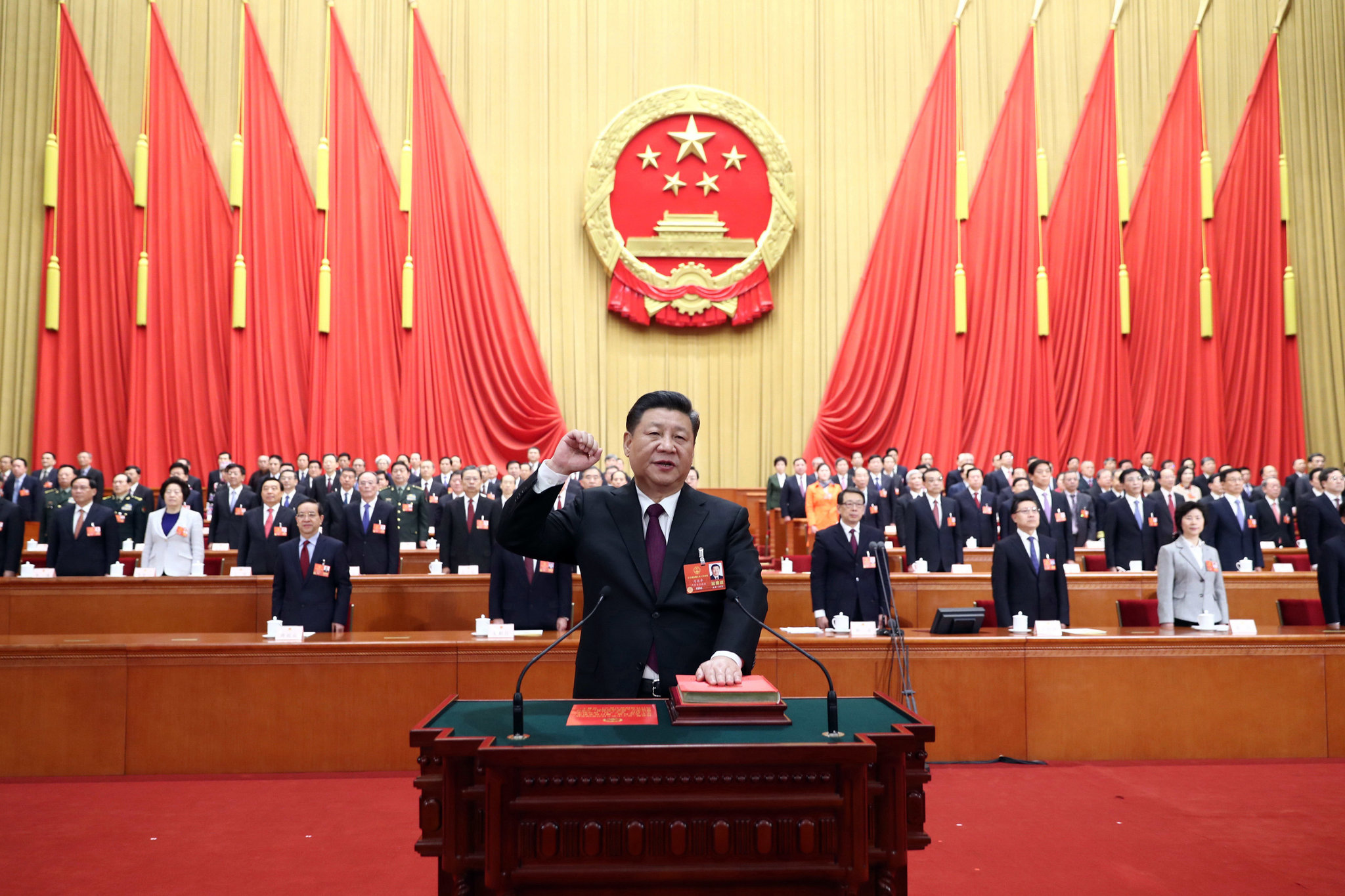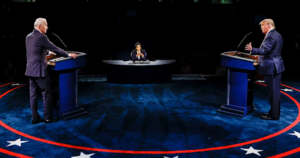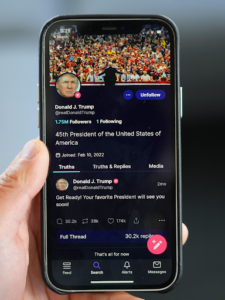Cementing itself as a center-stage issue for Western nations, China’s ongoing economic growth and infrastructural fortification call for heightened American vigilance, but certainly not panic.
Republican and Democrat leaders have failed in accurately conveying the present magnitude of China’s continuous gains and their future international impact. China is not the immediate threat to Democracy or the Judeo-Christian West that many right-wing pundits insist, nor is it the left’s ideal model of a peaceful nation’s socialist reforms on capitalism. There are a myriad of economic, social and geopolitical factors comprising U.S.-China relations, but the advancing nation should be viewed in a bipartisan light as the United States’s chief competitor and at the very least, recognized as a potential threat to current global stability.
The most recent data from Pew Research Center indicates Americans are divided on what a responsive strategy to China’s development looks like. According to the study published on March 4, 2021, “Roughly nine-in-ten U.S. adults (89%) consider China a competitor or an enemy, rather than a partner.” The same data found only 15% of Americans have confidence in Xi Jinping to “do the right thing regarding world affairs,” while 82% do not. Additionally, most surveyed Republicans and Democrats agreed in ranking China’s human rights abuses and growing economy as primary concerns.
At the core, former President Trump was entirely justified in working towards lessening U.S. dependency on China, as many experts hypothesize the coming decades will consist of both nations decoupling from one another. The Trump administration waged an economic war against China through increasing tariffs on an array of Chinese products, which according to the Federal Reserve Bank of St. Louis, generated over $79 billion in 2019. But there is a necessary debate over whether or not these tariffs truly benefitted American workers.
According to Brookings, “the tariffs on steel products appear to have helped create several thousand jobs in the steel industry; similarly, tariffs on washing machines are associated with approximately 1,800 new jobs at Whirlpool, Samsung and LG factories in the US.” But the counterposition argues much of the generated $79 billion comes from American households, which some studies estimate American consumers paid around $817,000 in higher prices attributable to the tariffs for every job created in the washing machine industry and $900,000 in the steel industry.
President Biden’s approach is much less outwardly aggressive and uses more discretion in its competitive efforts against China. On March 9, 2021, the White House announced Biden will participate in an online meeting on Friday, March 12 with leaders of Japan, India and Australia, otherwise known as the “quad” countries. The meeting will cover China’s aggressive foreign policy measures in the Indo-Pacific region and work towards forming a shared strategy in dealing with “supply chains, emerging and critical technologies, maritime security and climate change,” according to Reuters.
This virtual summit is well overdue. In January, just three days after Biden’s inauguration, the Chinese government simulated missile attacks on a U.S. aircraft carrier after its entrance into Taiwan’s air defense zone. More recently, Rear Admiral Doug Verissimo, commander of the USS Theodore Roosevelt aircraft carrier strike group, said over recent months in the South China Sea, Chinese military activity has increased “steadily.” The People’s Liberation Army consists of more than 2 million military personnel, enhanced weapons systems and since the 2021 National People’s Congress announcement, a defense budget of 1.36 trillion yuan, or $209.16 billion. This year’s recently announced defense budget is a 6.8% increase from 2020’s budget of 1.27 trillion yuan. Similar to 2019, when China’s defense budget was 40% higher than the original amount disclosed, the U.S. Department of Defense stated in a 2020 report that the country could be spending more than $200 billion on its military.
Delivering his first speech since Biden’s move into the White House, China’s top diplomat, Yang Jiechi, issued a clear warning to the U.S. during his address to the National Committee on U.S.-China Relations. Yang said, “the US should stop interference in the affairs of Hong Kong, Tibet and Xinjiang, which all matter to China’s sovereignty and territorial integrity.” If there is any kind of militaristic conflict with the PLA, it will likely occur in the South China Sea. Separated by 443 nautical miles of water, Hong Kong and Taiwan are likely the two foremost territories with significant pro-democracy movements calling for independence from Mainland China. In addition to announcing the increased defense budget, the Chinese Communist Party revealed a new election law intending to raise Hong Kong’s 70-seat Legislative Council, to 90 seats and thereby providing the CCP with a fixed majority of power over the disputed region’s government.
Admiral Philip Davidson, head of the Indo-Pacific Command, spoke about the U.S.’s dwindling advantage in the region. On the subject of China’s aggressive military activity around Taiwan, Davidson said, “At some point, you’re going to see fighters. There’ll be a few at first and then they’ll try to do the boiling frog sort of approach. … Pretty soon they’ll have as much as they want to deploy there.” Those fearful of China’s military activity should be comforted in knowing the substantial difference in comparing its nuclear arsenal with that of the U.S. Bonnie Glaser, a distinguished expert at the Center for Strategic and International Studies, said, “If China quadruples its stockpile of nuclear warheads, it increases from the low 200s … to approximately 900.” Outlined in the New Start Treaty signed in April 2010, the U.S. is restricted to only 1,550 deployed nuclear warheads. Even if China’s nuclear arsenal was quadrupled, it would still stand miles behind the U.S.’s total nuclear stockpile of 3,800.
Addressing China’s irrefutable successes in the technology sector is of critical importance, especially in preventing the formation of a similar surveillance state in the West. Between 2010 and 2019, orders from the Chinese government for facial recognition cameras and surveillance-related equipment increased by roughly 1,900%, according to a publication from the Center on U.S.-China Relations. Chinese state media declared that in Beijing alone there are upwards of 850,000 informants either on payroll or volunteering to help China expel any anti-communist activity and dissidence regarding the state, its leaders or the government. Ultimately, China is shifting towards a social credit system, where the government records citizens’ surveilled behaviors and interactions, all of which are kept on file.
A report from the U.S. National Security Commission on Artificial Intelligence says, “Within the next decade, China could surpass the U.S. as the world’s AI superpower.” The same report emphatically stresses the necessity for the U.S. to produce more domestic-born talent in the field. Cryptocurrency is somewhat of an international phenomenon and China’s current method of digital currency could easily set the new norm in the world’s evolving financial landscape.
According to CNBC, mobile payments in China “more than doubled to $5 trillion in 2016,” and in 2017’s first quarter, “Alipay has 54% of that mobile payments market, and WeChat accounted for 40%.” The appeal of most cryptos is that they are decentralized, unlike China’s digital currency, which is directly connected to the Chinese government. An anonymous head of Asia business at a prominent Wall Street bank informed the Financial Times that, “The digital renminbi will put every transaction on the radar of the People’s Bank of China.”
Since China’s sweeping economic reforms in 1978, the country has averaged almost 10% growth in GDP per year, and over 850 million Chinese people have been lifted out of poverty. However, the nation’s per-capita income is barely higher than a quarter of all high-income countries. Furthermore, 73 million people are living below the upper-middle-income poverty line of $5.50 a day, according to data from World Bank. China is also falling short in its number of dependable allies, particularly when compared to the U.S., which has over 70.
China still has some way to go before it is considered a global superpower but that does not mean it will not be. The responsibility of creating an effective strategy of economic decoupling and holding the CCP accountable for its human rights abuses lays on the shoulders of elected U.S. officials. Meanwhile, nothing can supplement the average American voter’s responsibility to remain accurately informed and refrain from propaganda-induced hostility or apathy towards China.
Cementing itself as a center-stage issue for Western nations, China’s ongoing economic growth and infrastructural fortification call for heightened American vigilance, but certainly not panic.
Republican and Democrat leaders have failed in accurately conveying the present magnitude of China’s continuous gains and their future international impact. China is not the immediate threat to Democracy or the Judeo-Christian West that many right-wing pundits insist, nor is it the left’s model for a peaceful nation’s socialist reforms on capitalism. There are a myriad of economic, social and geopolitical factors comprising U.S.-China relations, but the advancing nation should be viewed in a bipartisan light as the United States’s chief competitor and at the very least, recognized as a potential threat to current global stability.
The most recent data from Pew Research Center indicates Americans are divided on what a responsive strategy to China’s development looks like. According to the study published on March 4, 2021, “Roughly nine-in-ten U.S. adults (89%) consider China a competitor or an enemy, rather than a partner.” The same data found only 15% of Americans have confidence in Xi Jinping to “do the right thing regarding world affairs,” while 82% do not. Additionally, most surveyed Republicans and Democrats agreed in ranking China’s human rights abuses and growing economy as primary concerns.
At the core, former President Trump was entirely justified in working towards lessening U.S. dependency on China, as many experts hypothesize the coming decades will consist of both nations decoupling from one another. The Trump administration waged an economic war against China through increasing tariffs on an array of Chinese products, which according to the Federal Reserve Bank of St. Louis, generated over $79 billion in 2019. But there is a necessary debate over whether or not these tariffs truly benefitted American workers.
According to Brookings, “the tariffs on steel products appear to have helped create several thousand jobs in the steel industry; similarly, tariffs on washing machines are associated with approximately 1,800 new jobs at Whirlpool, Samsung and LG factories in the US.” But the counterposition argues much of the generated $79 billion comes from American households, which some studies estimate American consumers paid around $817,000 in higher prices attributable to the tariffs for every job created in the washing machine industry and $900,000 in the steel industry.
President Biden’s approach is much less outwardly aggressive and uses more discretion in its competitive efforts against China. On March 9, 2021, the White House announced Biden will participate in an online meeting on Friday, March 12 with leaders of Japan, India and Australia, otherwise known as the “quad” countries. The meeting will cover China’s aggressive foreign policy measures in the Indo-Pacific region and work towards forming a shared strategy in dealing with “supply chains, emerging and critical technologies, maritime security and climate change,” according to Reuters.
This virtual summit is well overdue. In January, just three days after Biden’s inauguration, the Chinese government simulated missile attacks on a U.S. aircraft carrier after its entrance into Taiwan’s air defense zone. More recently, Rear Admiral Doug Verissimo, commander of the USS Theodore Roosevelt aircraft carrier strike group, said over recent months in the South China Sea, Chinese military activity has increased “steadily.” The People’s Liberation Army is comprised of more than 2 million military personnel, enhanced weapons systems and since the 2021 National People’s Congress announcement, a defense budget of 1.36 trillion yuan, or $209.16 billion. This year’s recently announced defense budget is a 6.8% increase from 2020’s budget of 1.27 trillion yuan. Similarly to 2019, when China’s defense budget was actually 40% higher than the original amount disclosed, the US Department of Defense stated in a 2020 report, that the country could be spending more than $200 billion on its military.
Delivering his first speech since Biden’s move into the White House, China’s top diplomat, Yang Jiechi, issued a clear warning to the U.S. during his address to the National Committee on U.S.-China Relations. Yang said, “the US should stop interference in the affairs of Hong Kong, Tibet and Xinjiang, which all matter to China’s sovereignty and territorial integrity.” If there is any kind of militaristic conflict with the PLA, it will likely occur in the South China Sea. Separated by 443 nautical miles of water, Hong Kong and Taiwan are likely the two foremost territories with significant pro-democracy movements calling for independence from Mainland China. In addition to announcing the increased defense budget, the Chinese Communist Party revealed a new election law intending to raise Hong Kong’s 70-seat Legislative Council, to 90-seats and thereby providing the CCP with a fixed majority of power over the disputed region’s government.
Admiral Philip Davidson, head of the Indo-Pacific Command, spoke about the U.S.’s dwindling advantage in the region. On the subject of China’s aggressive military activity around Taiwan, Davidson said, “At some point, you’re going to see fighters. There’ll be a few at first and then they’ll try to do the boiling frog sort of approach. … Pretty soon they’ll have as much as they want to deploy there.” Those fearful of China’s military activity should be comforted in knowing the substantial difference in comparing its nuclear arsenal with that of the U.S. Bonnie Glaser, a distinguished expert at the Center for Strategic and International Studies, said, “If China quadruples its stockpile of nuclear warheads, it increases from the low 200s … to approximately 900.” Outlined in the New Start Treaty signed in April 2010, the U.S. is restricted to only 1,550 deployed nuclear warheads. Even if China’s nuclear arsenal was quadrupled, it would still stand miles behind the U.S.’s total nuclear stockpile of 3,800.
Addressing China’s irrefutable successes in the technology sector is of critical importance, especially in preventing the formation of a similar surveillance state in the West. Between 2010 and 2019, orders from the Chinese government for facial recognition cameras and surveillance-related equipment increased by roughly 1,900%, according to a publication from the Center on U.S.-China Relations. Chinese state media declared that in Beijing alone there are upwards of 850,000 informants who are either on payroll or volunteering to help China expel any anti-communist activity and dissidence regarding the state, its leaders, or the government. Ultimately, China is shifting towards a social credit system, where the government records citizens’ surveilled behaviors and interactions, all of which are kept on file.
A report from the U.S. National Security Commission on Artificial Intelligence says, “Within the next decade, China could surpass the U.S. as the world’s AI superpower.” The same report emphatically stresses the necessity for the U.S. to produce more domestic-born talent in the field. Cryptocurrency is somewhat of an international phenomenon and China’s current method of digital currency could easily set the new norm in the world’s evolving financial landscape.
According to CNBC, mobile payments in China “more than doubled to $5 trillion in 2016,” and in 2017’s first quarter, “Alipay has 54% of that mobile payments market, and WeChat accounted for 40%.” The appeal of most cryptos is that they are decentralized, unlike China’s digital currency, which is directly connected to the Chinese government. An anonymous head of Asia business at a prominent Wall Street bank informed the Financial Times that, “The digital renminbi will put every transaction on the radar of the People’s Bank of China.”
Since China’s sweeping economic reforms in 1978, the country has averaged almost 10% growth in GDP per year, and over 850 million Chinese people have been lifted out of poverty. However, the nation’s per-capita income is barely higher than a quarter of high-income countries. Furthermore, 73 million people are living below the upper-middle-income poverty line of $5.50 a day, according to data from World Bank. China is also falling short in its number of dependable allies, particularly when compared to the U.S., which has over 70.
China still has some way to go before it is considered a global superpower but that does not mean it will not be. A comprehensive analysis of the current U.S.-China situation is impossible to do justice in a single article, as there are numerous factors necessitating updated coverage. The responsibility of creating an effective strategy of economic decoupling and holding the CCP accountable for its human rights abuses lay on the shoulders of elected U.S. officials. Meanwhile, nothing can supplement the average American voter’s responsibility to remain accurately informed and refrain from propaganda-induced hostility or apathy towards China.














Be First to Comment